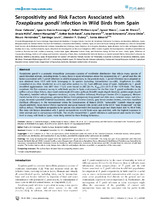Seropositivity and Risk Factors Associated with Toxoplasma gondii Infection in Wild Birds from Spain

Ver/
Autor
Cabezón, Oscar
Molina-López, Rafael
Marco, Ignasi
Blanco, Juan M.
Höfle, Ursula
Margalida, Antoni
Bach-Raich, Esther
Darwich, Laila
Echeverría, Israel
Obón, Elena
Hernández, Mauro
Lavín, Santiago
Dubey, Jitender P.
Almería, Sonia
García-Bocanegra, Ignacio
Editor
Public Libray of Science (PLOS)Fecha
2011Materia
Toxoplasma gondiiZoonosis
Wild bird
Spain
METS:
Mostrar el registro METSPREMIS:
Mostrar el registro PREMISMetadatos
Mostrar el registro completo del ítemResumen
Toxoplasma gondii is a zoonotic intracellular protozoan parasite of worldwide distribution that infects many species of
warm-blooded animals, including birds. To date, there is scant information about the seropositivity of T. gondii and the risk
factors associated with T. gondii infection in wild bird populations. In the present study, T. gondii infection was evaluated on
sera obtained from 1079 wild birds belonging to 56 species (including Falconiformes (n = 610), Strigiformes (n = 260),
Ciconiiformes (n = 156), Gruiformes (n = 21), and other orders (n = 32), from different areas of Spain. Antibodies to T. gondii
(modified agglutination test, MAT titer $1:25) were found in 282 (26.1%, IC95%:23.5–28.7) of the 1079 birds. This study
constitute the first extensive survey in wild birds species in Spain and reports for the first time T. gondii antibodies in the
griffon vulture (Gyps fulvus), short-toed snake-eagle (Circaetus gallicus), Bonelli’s eagle (Aquila fasciata), golden eagle (Aquila
chrysaetos), bearded vulture (Gypaetus barbatus), osprey (Pandion haliaetus), Montagu’s harrier (Circus pygargus), Western
marsh-harrier (Circus aeruginosus), peregrine falcon (Falco peregrinus), long-eared owl (Asio otus), common scops owl (Otus
scops), Eurasian spoonbill (Platalea leucorodia), white stork (Ciconia ciconia), grey heron (Ardea cinerea), common moorhen
(Gallinula chloropus); in the International Union for Conservation of Nature (IUCN) ‘‘vulnerable’’ Spanish imperial eagle
(Aquila adalberti), lesser kestrel (Falco naumanni) and great bustard (Otis tarda); and in the IUCN ‘‘near threatened’’ red kite
(Milvus milvus). The highest seropositivity by species was observed in the Eurasian eagle owl (Bubo bubo) (68.1%, 98 of 144).
The main risk factors associated with T. gondii seropositivity in wild birds were age and diet, with the highest exposure in
older animals and in carnivorous wild birds. The results showed that T. gondii infection is widespread and can be at a high
level in many wild birds in Spain, most likely related to their feeding behaviour.
